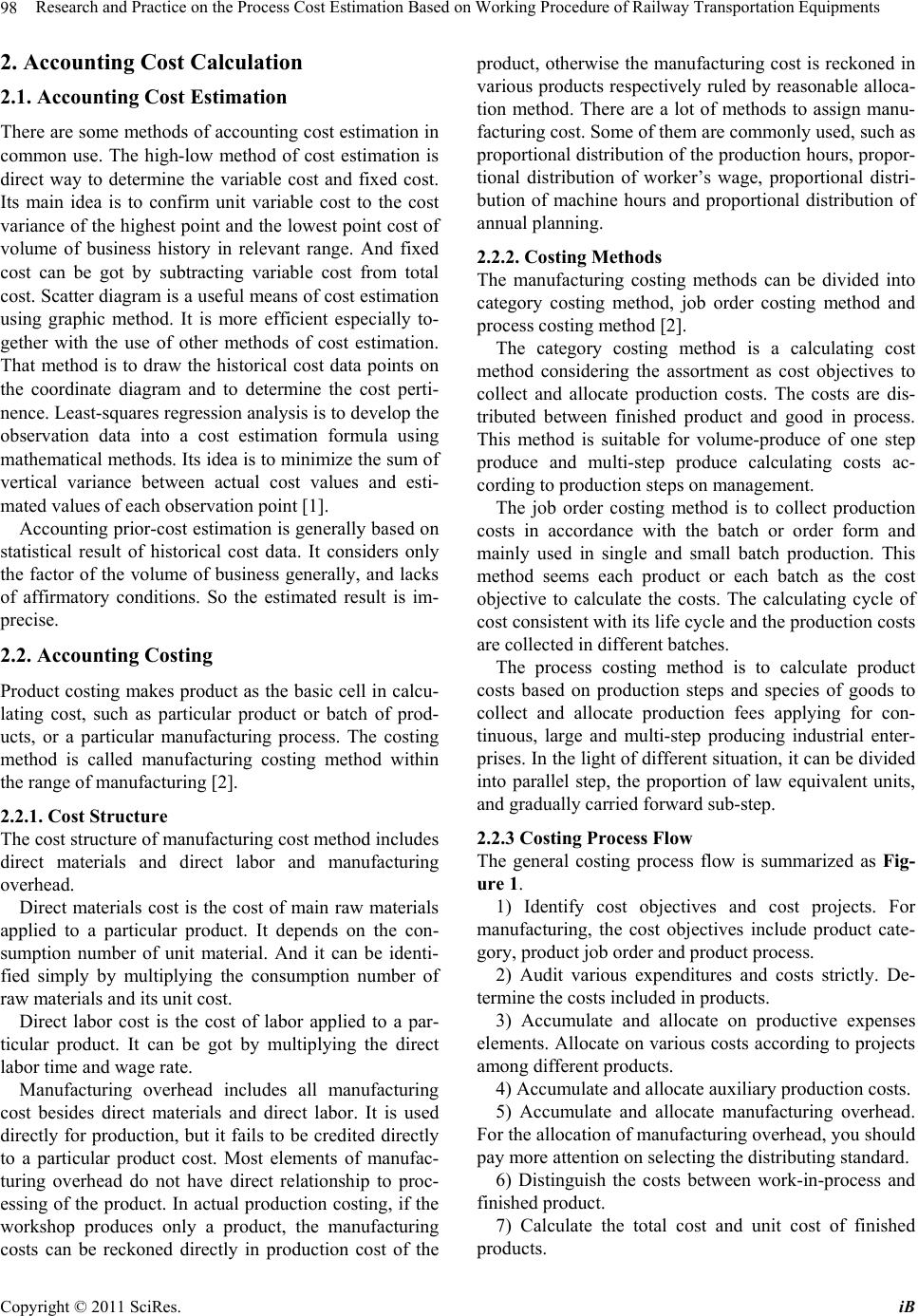
Research and Practice on the Process Cost Estimation Based on Working Procedure of Railway Transportation Equipments
98
2. Accounting Cost Calculation
2.1. Accounting Cost Estimation
There are some methods of accounting cost estimation in
common use. The high-low method of cost estimation is
direct way to determine the variable cost and fixed cost.
Its main idea is to confirm unit variable cost to the cost
variance of the highest point and the lowest point cost of
volume of business history in relevant range. And fixed
cost can be got by subtracting variable cost from total
cost. Scatter diagram is a useful means of cost estimation
using graphic method. It is more efficient especially to-
gether with the use of other methods of cost estimation.
That method is to draw the historical cost data points on
the coordinate diagram and to determine the cost perti-
nence. Least-squares regression analysis is to develop the
observation data into a cost estimation formula using
mathematical methods. Its idea is to minimize the sum of
vertical variance between actual cost values and esti-
mated values of each observation point [1].
Accounting prior-cost estimation is generally based on
statistical result of historical cost data. It considers only
the factor of the volume of business generally, and lacks
of affirmatory conditions. So the estimated result is im-
precise.
2.2. Accounting Costing
Product costing makes product as the basic cell in calcu-
lating cost, such as particular product or batch of prod-
ucts, or a particular manufacturing process. The costing
method is called manufacturing costing method within
the range of manufacturing [2].
2.2.1. Cost Stru cture
The cost structure of manufacturing cost method includes
direct materials and direct labor and manufacturing
overhead.
Direct materials cost is the cost of main raw materials
applied to a particular product. It depends on the con-
sumption number of unit material. And it can be identi-
fied simply by multiplying the consumption number of
raw materials and its unit cost.
Direct labor cost is the cost of labor applied to a par-
ticular product. It can be got by multiplying the direct
labor time and wage rate.
Manufacturing overhead includes all manufacturing
cost besides direct materials and direct labor. It is used
directly for production, but it fails to be credited directly
to a particular product cost. Most elements of manufac-
turing overhead do not have direct relationship to proc-
essing of the product. In actual production costing, if the
workshop produces only a product, the manufacturing
costs can be reckoned directly in production cost of the
product, otherwise the manufacturing cost is reckoned in
various products respectively ruled by reasonable alloca-
tion method. There are a lot of methods to assign manu-
facturing cost. Some of them are commonly used, such as
proportion al distribution of the prod uction hours, propor-
tional distribution of worker’s wage, proportional distri-
bution of machine hours and proportional distribution of
annual planning.
2.2.2. Costing Methods
The manufacturing costing methods can be divided into
category costing method, job order costing method and
process costing method [2].
The category costing method is a calculating cost
method considering the assortment as cost objectives to
collect and allocate production costs. The costs are dis-
tributed between finished product and good in process.
This method is suitable for volume-produce of one step
produce and multi-step produce calculating costs ac-
cording to production steps on management.
The job order costing method is to collect production
costs in accordance with the batch or order form and
mainly used in single and small batch production. This
method seems each product or each batch as the cost
objective to calculate the costs. The calculating cycle of
cost consistent with its life cycle and the produ ction costs
are collected in different batches.
The process costing method is to calculate product
costs based on production steps and species of goods to
collect and allocate production fees applying for con-
tinuous, large and multi-step producing industrial enter-
prises. In the light of different situation, it can be divided
into parallel step, the proportion of law equivalent units,
and gradually carried forward sub-step.
2.2.3 Costing Process Flow
The general costing process flow is summarized as Fig-
ure 1.
1) Identify cost objectives and cost projects. For
manufacturing, the cost objectives include product cate-
gory, product job order and product process.
2) Audit various expenditures and costs strictly. De-
termine the costs includ ed in products.
3) Accumulate and allocate on productive expenses
elements. Allocate on various costs according to projects
among different products.
4) Accumulate and allocate au xiliary production costs.
5) Accumulate and allocate manufacturing overhead.
For the allocation of manuf acturing overhead, you sh ould
pay more attention on selecting the distributing standard.
6) Distinguish the costs between work-in-process and
finished product.
7) Calculate the total cost and unit cost of finished
products.
Copyright © 2011 SciRes. iB